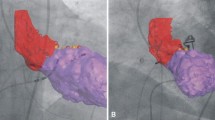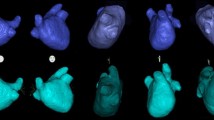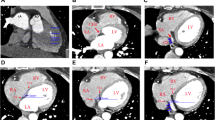Abstract
Rotational angiography is a novel method for three-dimensional reconstruction of the left atrium and pulmonary veins during catheter ablation for atrial fibrillation, but is still hampered by suboptimal reconstructions in a considerable number of patients. We describe the results of rapid pacing of the right ventricle for optimization of image acquisition during rotational angiography.


Similar content being viewed by others
References
Suzuki S, Yamashita T, Otsuka T, Sagara K, Uejima T, Oikawa Y, Yajima J, Koike A, Nagashima K, Kirigaya H, Ogasawara K, Sawada H, Yamazaki T, Aizawa T (2009) Treatment strategy and clinical outcome in Japanese patients with atrial fibrillation. Heart Vessels 24:287–293
Chiladakis J, Koutsogiannis N, Kalogeropoulos A, Zagli F, Arvanitis P, Alexopoulos D (2008) Usefulness of rate regulation through continuous ventricular pacing in patients with drug-controlled slower atrial fibrillation and normal or depressed left ventricular systolic function. Heart Vessels 23:403–408
Orlov MV, Hoffmeister P, Chaudhry GM, Almasry I, Gijsbers GH, Swack T, Haffajee CI (2007) Three-dimensional rotational angiography of the left atrium and esophagus—a virtual computed tomography scan in the electrophysiology lab? Heart Rhythm 4:37–43
Thiagalingam A, Manzke R, D’Avila A, Ho I, Locke AH, Ruskin JN, Chan RC, Reddy VY (2008) Intraprocedural volume imaging of the left atrium and pulmonary veins with rotational X-ray angiography: implications for catheter ablation of atrial fibrillation. J Cardiovasc Electrophysiol 19:293–300
Nölker G, Gutleben KJ, Marschang H, Ritscher G, Asbach S, Marrouche N, Brachmann J, Sinha AM (2008) Three-dimensional left atrial and esophagus reconstruction using cardiac C-arm computed tomography with image integration into fluoroscopic views for ablation of atrial fibrillation: accuracy of a novel modality in comparison with multislice computed tomography. Heart Rhythm 5:1651–1657
Kriatselis C, Tang M, Roser M, Fleck E, Gerds-Li H (2009) A new approach for contrast-enhanced X-ray imaging of the left atrium and pulmonary veins for atrial fibrillation ablation: rotational angiography during adenosine-induced asystole. Europace 11:35–41
Ector J, De Buck S, Nuyens D, Rossenbacker T, Huybrechts W, Gopal R, Maes F, Heidbüchel H (2009) Adenosine-induced ventricular asystole or rapid ventricular pacing to enhance three-dimensional rotational imaging during cardiac ablation procedures. Europace 11:751–762
Gerds-Li J-H, Tang M, Kriatselis C, Roser M, Goetze S, He D, Fleck E (2009) Rapid ventricular pacing to optimize rotational angiography in atrial fibrillation ablation. J Interv Card Electrophysiol 26:101–107
Tang M, Kriatselis C, Ye G, Nedios S, Roser M, Solowjowa N, Fleck E, Gerds-Li JH (2009) Reconstructing and registering three-dimensional rotational angiogram of left atrium during ablation of atrial fibrillation. Pacing Clin Electrophysiol 32:1407–1416
Li JH, Haim M, Movassaghi B, Mendel JB, Chaudhry GM, Haffajee CI, Orlov MV (2009) Segmentation and registration of three-dimensional rotational angiogram on live fluoroscopy to guide atrial fibrillation ablation: a new online imaging tool. Heart Rhythm 6:231–237
Author information
Authors and Affiliations
Corresponding author
Additional information
S. Hilbert and N. Dagres contributed equally to this manuscript and are joint first authors.
Rights and permissions
About this article
Cite this article
Hilbert, S., Dagres, N., Hindricks, G. et al. Rapid ventricular pacing: a fast, reliable, and safe technique for optimization of image acquisition during rotational angiography for catheter ablation of atrial fibrillation. Heart Vessels 26, 349–352 (2011). https://doi.org/10.1007/s00380-010-0023-2
Received:
Accepted:
Published:
Issue Date:
DOI: https://doi.org/10.1007/s00380-010-0023-2




